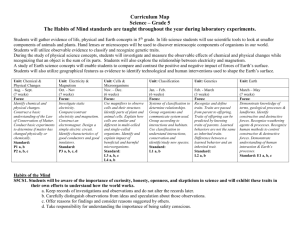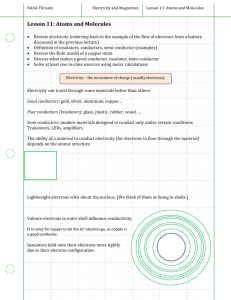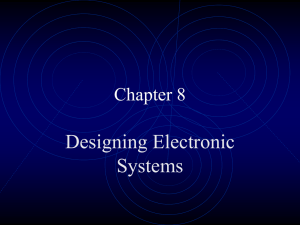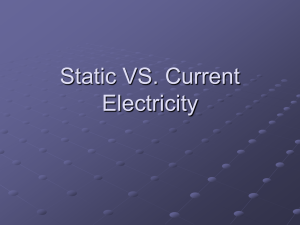CRCT Science Study Guide
advertisement
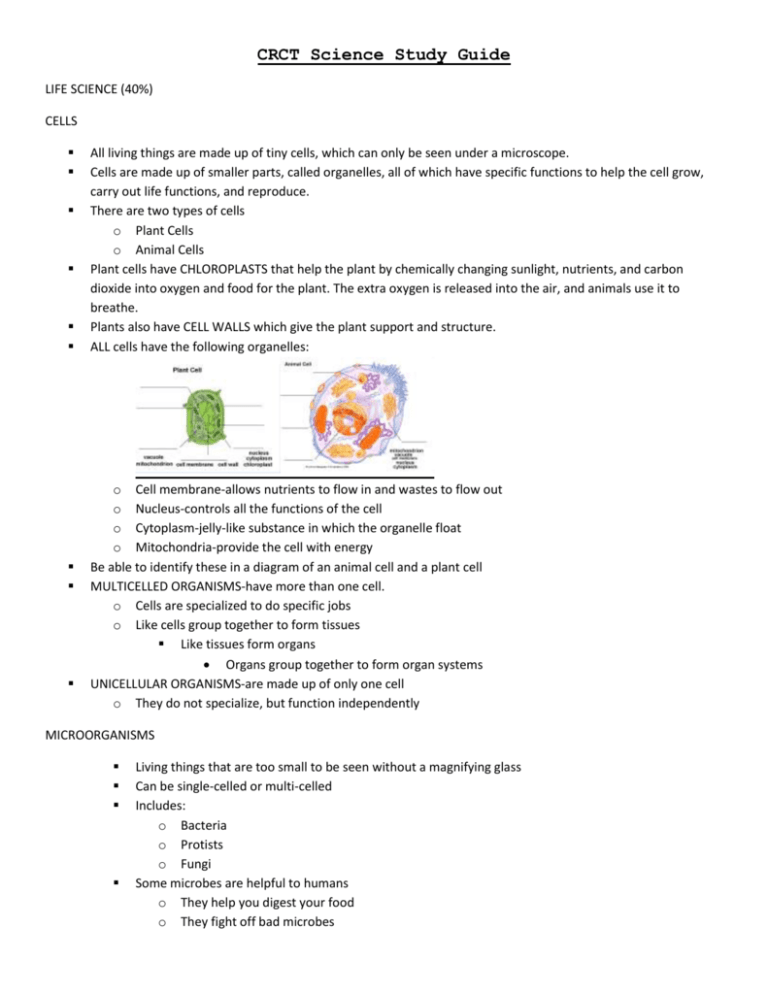
CRCT Science Study Guide LIFE SCIENCE (40%) CELLS All living things are made up of tiny cells, which can only be seen under a microscope. Cells are made up of smaller parts, called organelles, all of which have specific functions to help the cell grow, carry out life functions, and reproduce. There are two types of cells o Plant Cells o Animal Cells Plant cells have CHLOROPLASTS that help the plant by chemically changing sunlight, nutrients, and carbon dioxide into oxygen and food for the plant. The extra oxygen is released into the air, and animals use it to breathe. Plants also have CELL WALLS which give the plant support and structure. ALL cells have the following organelles: o Cell membrane-allows nutrients to flow in and wastes to flow out o Nucleus-controls all the functions of the cell o Cytoplasm-jelly-like substance in which the organelle float o Mitochondria-provide the cell with energy Be able to identify these in a diagram of an animal cell and a plant cell MULTICELLED ORGANISMS-have more than one cell. o Cells are specialized to do specific jobs o Like cells group together to form tissues Like tissues form organs Organs group together to form organ systems UNICELLULAR ORGANISMS-are made up of only one cell o They do not specialize, but function independently MICROORGANISMS Living things that are too small to be seen without a magnifying glass Can be single-celled or multi-celled Includes: o Bacteria o Protists o Fungi Some microbes are helpful to humans o They help you digest your food o They fight off bad microbes o Can be used to make bread, yogurt, and cheese Other microbes are harmful to humans o Can cause diseases like: Chicken pox Food Poisoning E-Coli Salmonella Measles, Mumps Strep Throat o VACCINES are shots of the microbe (dead or weakened) that cause the body to produce ANTIBODIES against it. Vaccines protect us from these harmful microbes. CLASSIFICATION OF LIVING THINGS Scientists classify living things in order to: o Group organisms that are similar in structure and function o Observe new species as they relate to known classification groups There are 7 levels of classification, going from most general to most specific: o Kingdom o Phylum o Class o Order o Family o Genus o Species Remember this with the phrase “King Phillip Came Over For Grape Soda” Scientific names include the species and genus-come from the Latin root SIX KINGDOMS o Archaebacteria o Eubacteria o Protists o Fungi o Animals o Plants PLANT GROUPS o Two groups of plants Vascular-with tube-like structures 1. Transport water through these tubes-can grow tall 2. Seeded –produce flowers and fruits 3. Non-seeded-produce spores instead of seeds Non-vascular-no tube structures 1. Soak up water like a sponge 2. Must grow close to the ground and 3. Close to water ANIMAL GROUPS o Two types of animals Invertebrates-NO backbones Vertebrates-Have backbones 1. Fish-cold blooded, lay eggs, breathe with gills, live in water 2. Amphibians-lay eggs, breathe with gills, grow lungs as adults-water/land 3. Reptiles-breathe with lungs, dry scaly skin, live on land and water 4. Birds-have feathers, light bones, lay eggs, warm-blooded 5. Mammals-have fur or hair, nurse their babies, warm-blooded INHERITED TRAITS VS. LEARNED BEHAVIORS Offspring look like their parents because of INHERITED TRAITS o These are found on a person’s GENES-located on DNA in every cell. Genes determine physical traits, like eye color, hair color, height Some behaviors may be inherited (instincts in animals, for example) o One half of the genetic information comes from each parent o Some traits are DOMINANT and some traits are RECESSIVE Dominant traits show up when only one parent passes it on. Recessive traits only show up when both parents pass it on. Some traits are LEARNED, not inherited o Manners, habits, ways of speaking o They are things that have been developed since birth. PHYSICAL SCIENCE (30%) Any object is a sum of its parts The mass of an object is equal to the sum of the mass of all its parts Some objects (such as cells and atoms) have parts that are too small to be seen without magnification. Scientists used magnifying glasses and microscopes to see these objects. Explain the difference between a physical change and a chemical change A PROPERTY describes how matter looks, feels or interacts with other matter. Physical properties can be observed without changing the true identity of the objects. o Examples include: State of matter (solid, liquid, gas) Melting point (the temperature at which a solid becomes a liquid) Boiling point (the temperature at which a liquid becomes a gas) Electrical conductivity (does it allow electricity to flow through it?) Thermal conductivity (does it allow heat to flow through it?) Magnetism (the ability o attract or repel of the matter) Physical CHANGES are things that change matter from one form to another. In a physical change, nothing new is created. o Examples include: Ice melting-it is still the same type of matter, it has just changed phase Paper being torn apart-the shape and size has changed, but it is still paper Mixtures-different types of matter are mixed together, but they still retain the same properties as before. They can be easily separated from each other by filtering, shaking, or separating by hand Solutions-one substance is dissolved in another. The matter still retains its identity. They can be separated out, but not as easily. Evaporation of a liquid will separate out some solutions. Chemical properties describe the way a substance may change or react to form a new substance o Examples include: Flammability (the ability to burn) Reactivity (the response of one substance to another) Rusting (iron reacting with oxygen) Chemical changes occur when matter changes from one form to a new form. Evidence of chemical changes include: o Heat is produced that was not there before. o Light is produced that was not there before. o Fumes or smoke are produced. o The substance fizzes, changes color, or smells different. o A solid substance appears that was not there before. Electricity and Magnetism All atoms are made of protons (positive charges) neutrons (no charge) and electrons (negative charges) Electricity happens when electrons (which surround the atom) move There are two types of electricity: o Static Electricity-electrons are removed from an object or collect on an object. We say that the object is ELECTRICALLY CHARGED. Electrons eventually DISCHARGE. This can happen slowly (when a balloon sticking to the wall eventually falls) or quickly (like a shock when you touch a conductor or a lightning strike) o Current Electricity-electrons flow from place to place by moving along atoms. Conductors are materials that allow electrons to flow easily through them (copper, aluminum, steel, and other metals, water) Insulators are materials that do not allow electrons to flow easily through them (rubber, wood, plastic, cloth, and other non-metals) Electricity can flow in a COMPLETE, CLOSED PATH which is called a CIRCUIT o In CIRCUITS, there are 3 main components: Power source-a generator or a battery Load-anything that you want to use the electricity Path for electrons to flow (usually a wire) Switches are often used in circuits. They allow us to control the flow of electrons. Electricity can only flow when the circuit is CLOSED. If it is open, electricity will not flow. Magnetism o A magnet is anything that produces magnetic field lines. o Magnets can attract or repel other magnetic objects. o Like poles repel (push away) and unlike poles attract (pull towards) each other. o There are two types of magnets Permanent magnets are designed to keep their magnetism for a very long time. Temporary magnets can be made from some materials by rubbing a magnet across them. Doing this lines up the magnetic domains within the object. Temporary magnets can DEMAGNETIZE when they are dropped or heated up. Electromagnetism o Electricity and magnetism are closely related. o When electricity flows through a wire, a magnetic field is produced around the wire. o By wrapping the wire around a conductor, like iron, an electromagnet can be made. o An electromagnet is a TEMPORARY magnet. It is only magnetic while electricity if flowing through it. o This is useful, because it helps us do work (like generating electricity or picking up scrap metal in a junkyard) EARTH SCIENCE (30%) Surface Features of the Earth-The Earth is made of four main layers: o Crust-thin, solid, outermost layer-broken into pieces like a cracked egg o Mantle-thickest layer, made of mostly iron, magnesium and other metals. This layer flows slowly o Outer Core-molten (melted) metals make up this layer o Inner Core-solid metal layer made of iron and nickel. Plate Tectonics o It is the study of how the plates of the Earth’s crust move. o There are 17 large plates, and several small ones that make up the lithosphere. o Scientists believe that at one time, all the continents were joined in a supercontinent called “Pangaea” meaning “all earth” o Plates move because they float on top of a more fluid layer of the mantle called the asthenosphere. o In the ocean, hot lava rises up from the mid-ocean ridge, cools and hardens, pushing the plates apart. This is called SEA FLOOR SPREADING Constructive Forces add new features to the surface of the Earth o Because of plate tectonics, new crust is always being added to the earth. Sea Floor Spreading The movement of plates towards each other causes MOUNTAIN BUILDING VOLCANOES-form new crust when they erupt. Volcanoes can occur where Plates come together (convergent boundaries) Plates move apart (divergent boundaries) At Hot Spots (weak areas in the crust where magma bubbles up) Deposition-when rocks and soil are moved down a river due to EROSION, they can then be deposited at the mouth of the river. This can forms a DELTA. Destructive Forces tear down the Earth’s crust. o Subduction-when one plate slides under the other, it is pulled into a deep sea trench. As it moves closer to the mantle, it melts and becomes part of the molten rock. o Weathering and Erosion Weathering is when rock is broken down into smaller and smaller pieces Mechanical weathering happens when rock is physically broken down. It can occur by wind, water, ice, or heat. Chemical weather happens when mineral within rocks are broken down by removing or altering the elements that make up the minerals. Biological weathering is caused by living organisms, and can be either mechanical or chemical Erosion is when soil or rock is carried away by water, ice or wind. It is the MOVEMENT of weathered rock. Water erosion-can occur when a river carries soil away. It can also occur when beaches are pounded by waves and carry away sand. Wind erosion-occurs everywhere, but especially in desert areas. The DUST BOWL in the 1930’s is an example of the power of wind erosion. EARTHQUAKES can break down crust in a very destructive way. They occur at PLATE BOUNDARIES when plates push together, pull apart, or rub against each other. Managing Earth’s Changes Scientists have ways of predicting events such as earthquakes, using seismometers o These early warnings can help evacuate areas that may be effected by earthquakes and tsunamis (giant waves caused when an earthquake in the ocean causes it to slosh) o Unfortunately, it’s not always possible to predict every event. Buildings can be designed to be able to withstand earthquakes. Flood Controls o Engineers develop ways to control the flow of water in cities such as: Storm drains Sewage systems Levees (barriers built on the banks of a body of water such as the ocean, made of dirt, sandbags, or concrete) Dams (can also be used to produce electricity using the flow of water to turn a turbine) Beach Reclamation o When heavy storms, such as hurricanes, destroy beaches and shorelines, engineers can do several things: Jetties-solid structures made of piled stones or other material that keeps water from flowing onto the beach Dredging-scooping out loose sand and earth from the ocean and then transporting it to the beach to rebuild the shoreline
